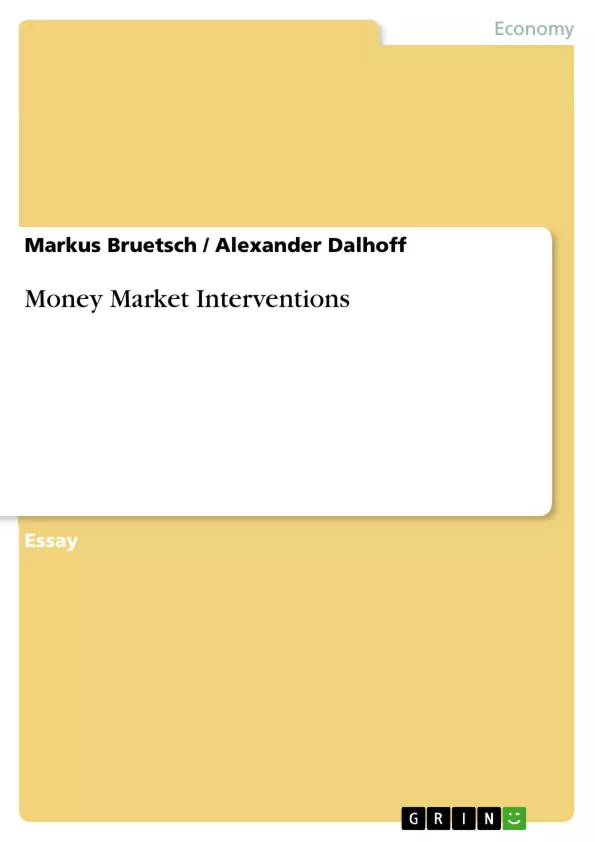After the collapse of the Bretton-Woods-System in 1973 and the transition to a
system of floating rates between the major global currencies, central banks still use
interventions for exchange rate maintenance. This paper aims to examine the
function of Central Bank operations in foreign exchange markets on the basis of two
empirical data sets, explaining both, appreciation and depreciation. It tries to analyse
the impacts on capital flows recorded in the balance of payments and the efficiency
of interventions. Further it will analyse the impacts on domestic monetary supplies
and if necessary how to sterilise these effects. At certain stages endnotes will refer to
the appendix for more detailed explanations or data. To illustrate, how central bank interventions work, we will take the European Central
Bank (ECB) as an example and concentrate on two currencies, the euro (€) and the
US dollar ($). [...] If the ECB aims at an appreciation of the own currency, the bank will engage in a
foreign exchange operation and buy euros against its US dollar reserves. The
demand for euros increases (demand curve shifts to the right) and simultaneously supply is reduced, because the ECB takes Euro out of the market (supply curve
shifts to the left). Through the forces of supply and demand the value of the euro will
strengthen in international markets (the exchange rate moves from r1 to r2).
Depreciation (see diagram 2)
If the ECB aims at a depreciation of the own currency, the bank will sell euros against
dollars. In this case, demand for euros declines (demand curve shifts to left) and the
supply increases (shift to the right) because the ECB pays the purchased dollars in
euro. Again, the forces of supply and demand determine the new exchange rate at r2.
The value of the euro will weaken in international markets (and inversely the US
dollar value will rise). [...]
Inhaltsverzeichnis (Table of Contents)
- Introduction
- The mechanism of exchange market operations
- Supporting the exchange rate
- The ECB intervention in September 2000
- Economic effects
- Balance of payments
- Capping the Exchange rate
- The FED intervention in 1985
- Economic effects
- Balance of payments
- Efficiency of interventions
- Monetary impacts of interventions
- Sterilisation of interventions
- Conclusion
Zielsetzung und Themenschwerpunkte (Objectives and Key Themes)
The paper aims to examine the function of Central Bank operations in foreign exchange markets, specifically analyzing both appreciation and depreciation of currencies through two empirical case studies. It focuses on understanding the impacts of these interventions on capital flows in the balance of payments, as well as assessing their efficiency in influencing exchange rates. The paper also investigates the impacts on domestic monetary supplies and methods for sterilizing these effects.
- The role of Central Banks in foreign exchange market interventions.
- The impact of interventions on exchange rates, both appreciation and depreciation.
- The impact of interventions on capital flows and the balance of payments.
- The efficiency of interventions in influencing exchange rates.
- The impacts of interventions on domestic monetary supplies and the need for sterilization.
Zusammenfassung der Kapitel (Chapter Summaries)
- Introduction: This chapter provides a brief overview of the transition to a floating exchange rate system after the collapse of the Bretton-Woods system in 1973. It also outlines the objectives of the paper, which include analyzing the effects of Central Bank interventions in foreign exchange markets, considering both appreciation and depreciation of currencies.
- The mechanism of exchange market operations: This chapter uses the European Central Bank (ECB) as an example to illustrate how Central Bank interventions work in the foreign exchange market. It explains how the ECB can influence the exchange rate by buying or selling euros against US dollars, impacting the demand and supply of euros in the market.
- Supporting the exchange rate: This chapter focuses on the ECB's intervention in September 2000, when it made extensive use of interventions to support the euro at its all-time low. It analyzes the economic effects of the intervention, particularly on the balance of payments.
- Capping the Exchange rate: This chapter examines the FED intervention in 1985, focusing on its economic effects, including the impact on the balance of payments. It explores how the intervention aimed to cap the appreciation of the US dollar against other major currencies.
- Efficiency of interventions: This chapter examines the effectiveness of interventions in influencing exchange rates, considering factors that may affect the outcomes of interventions.
- Monetary impacts of interventions: This chapter discusses the potential impacts of interventions on domestic monetary supplies and the need for sterilization to counteract these effects. It outlines methods that Central Banks can employ to neutralize the impact of interventions on the money base.
Schlüsselwörter (Keywords)
This paper focuses on Central Bank interventions in foreign exchange markets, analyzing their effects on exchange rates, balance of payments, and domestic monetary supplies. The key concepts explored include appreciation and depreciation of currencies, interventions in the foreign exchange market, capital flows, balance of payments, efficiency of interventions, monetary impacts, and sterilization.
- Arbeit zitieren
- Markus Bruetsch (Autor:in), Alexander Dalhoff (Autor:in), 2003, Money Market Interventions, München, GRIN Verlag, https://www.grin.com/document/14851



